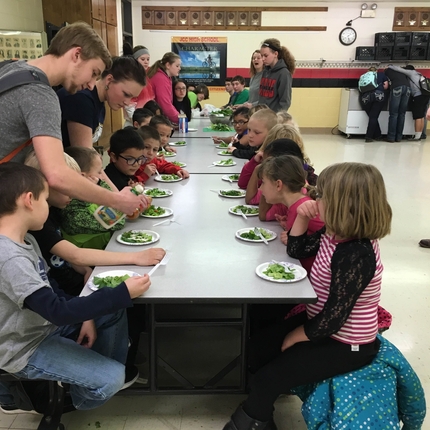After providing a lesson in the kindergarten classroom, we cut the lettuce to put in the school lunch program. Two students started jumping up and down saying “Yes! We get a salad for snack today!” The teacher said, “No that lettuce is going to go toward feeding the school today at lunch. We get graham crackers for a snack.” The whole class sighed in disappointment. -Christy Hodges
Farm to School programs are emerging around the Midwest, and the Center for Rural Affairs is in the midst of the momentum.
We met Christy Hodges, Johnson County Central School agricultural and biological science teacher, at the southeast Nebraska regional Farm to School conference in March 2015. She attended to learn more about meat regulations, curriculum and how to start the dialogue with her administration about local procurement for school meals.
After the conference, Hodges asked Center Project Specialist Sandra Renner for grant ideas. Sandra directed her to a Farm Credit Services grant for $2,000, which Christy applied for and was awarded.
Christy also joined us for the Midwest Farm to School Conference in Nebraska City earlier this year.
We caught up with her this summer, and learned that she has been able to purchase nine tower gardens at no cost to her or the school district. The food generated from the gardens are given to the school lunch program, eaten at snack time in the classroom, and allowed to be taken home to share with students’ families.
She has hands-on tower garden curriculum for kindergarten to second grade, third to sixth grade and seventh to 12th grade.
“My high school students have become experts and have done way better at teaching the elementary students than I ever intended,” Christy said. “It makes my heart happy to see the ownership my students have in the tower gardens and the eagerness they have to learn more about plants.”
Christy was introduced to tower gardens in July 2015 as a hands-on tool for botany classes at Johnson County Central and for Johnson-Brock distance learning.
“After about an hour of learning about the Aeroponic Growing Unit, I knew I had to have one for my classroom and one for the distance learning classroom at Johnson-Brock,” Christy said.
She started writing grants, and talked to parents, school board members, teachers and administration. However, the soonest any grant money would be available was March 2016.
“So, a parent working at Union Bank and Trust asked if the bank could buy one for us,” Christy said. “They graciously did just that and we were able to start tower gardening in January.”
By January, goals had changed from wanting a tower garden in the classroom to shaping botany students and FFA members into agricultural advocates.
The first tower garden was installed in the third grade classroom. Christy and her high school students visited every two to three weeks, providing lessons as the plants grew.
The botany students taught lessons on seed germination, plant nutrient requirements, plant anatomy, role of plant parts, pollination and the nutrition that plants give our bodies.
“We successfully provided the third graders with lessons they were able to completely understand because we had plants they could see, touch and even taste,” Christy said. “For example, when we taught about complete and incomplete flowers for pollination, we were able to show them the differences with a pepper plant and a cucumber.”
A pepper plant has a stamen (male organelles) and a pistil (female organelles) on the same flower and can self pollinate, while the cucumber has male and female parts on separate flowers.
Students were able to tell the difference between a male flower and a female flower, and they took on the role of pollinators (bees and butterflies) as they physically cross-pollinated the cucumber plant by hand.
While busy in the third grade classroom, Christy wrote more grants. Teachers and parents got excited and visited the classroom to see the tower garden, and teachers requested tower gardens for their classrooms.
By the beginning of March 2016, tower gardens were placed in the middle school science room, high school biology room, Christy’s classroom, Johnson-Brock distance learning room, both kindergarten classrooms, and a fourth grade classroom.
Community members learned about the plant lessons, and Farmers Bank of Cook donated money to buy another tower garden.
In the first year, tower gardens provided a “seed to plate” curriculum to over 300 K-12 students.
“We are eager to continue to use the tower gardens as an educational tool for years to come,” Christy said.
The teacher said the tower gardens are like magnets - getting kids’ attention while learning where their food comes from.
“We went into a kindergarten classroom, cut their lettuce and allowed them to take it home to share with their family for supper,” Christy said. “The next day, one student came back saying he was so mad at his mom. She ate the lettuce when she got home (before supper) while he was playing outside and that he didn’t get any of it.”





